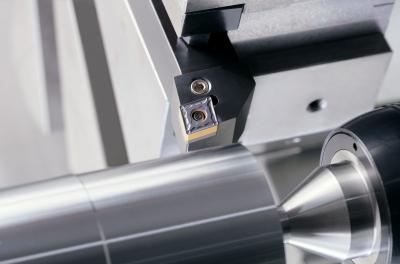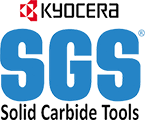
Kyocera is proud to announce the release of the new CA115P/CA125P next-gen CVD coated carbide, a cutting-edge solution for steel machining. This new offering combines an innovative coating, carbide substrate, and chip breakers to deliver exceptional performance, wear, and fracture resistance. The CA115P/CA125P series revolutionizes steel machining with remarkable endurance and longevity.
Kyocera has designed the CA115P/CA125 series to provide extended tool life and superior performance in a variety of machining scenarios. The CA115P is ideal for continuous to light-interrupted machining, offering highly efficient and precise results. Conversely, the CA125P is optimized for continuous to heavy interrupted machining, making it a versatile general-purpose tool for steel machining.
The newly developed proprietary coating and carbide substrate of the CA115P/CA125P series offers unmatched wear and fracture resistance. The coating properties on the rake and flank faces are optimized to provide excellent wear resistance. The black and gold appearance and stark contrast are beyond cosmetic in nature. The black rake face is composed of a highly uniform alumina layer reducing wear, suppressing cratering, and diminishing fracturing. The striking gold flank includes a hard surface layer, a highly uniform alumina layer, and a unique TiCN layer. All these layers on the flank work together to improve the wear-resistant properties of the insert and to suppress surface abrasion. Below the coating, the new carbide substrate displays enhanced resistance to plastic deformation and exhibits increased temperature resistance.
A key advantage of the CA115P/CA125P series is its expansive lineup of chipbreaker options covering everything from finishing to roughing, ensuring optimal performance and productivity across numerous applications. Kyocera is also introducing the new PMG chipbreaker design for optimal medium to roughing efficiency with lower resistance and protection against chip entanglement when machining steel.
Benefits:
-
Innovative new CVD coating technology suppresses cratering, diminishes wear and enables elevated fracture resistance
-
Ultra-uniform crystal orientation structure for excellent wear resistance
-
The gold flank finish on the insert enables easy edge defect detection
Features:
-
NEW PMG chipbreaker design for optimal medium to roughing efficiency
-
Expansive selection of chip breakers for a broad range of applications.
-
Extensive selection of positive and negative rake options.
-
Multiple insert styles available for continuous, light-interrupted,
interrupted, and heavy-interrupted machining
-
Multiple cutting edges per insert
Applications:
-
Ideal for machining steel in continuous to heavy interrupted applications with options for finishing or roughing
-
External and internal turning, facing, boring
Contact Details
Related Glossary Terms
- boring
boring
Enlarging a hole that already has been drilled or cored. Generally, it is an operation of truing the previously drilled hole with a single-point, lathe-type tool. Boring is essentially internal turning, in that usually a single-point cutting tool forms the internal shape. Some tools are available with two cutting edges to balance cutting forces.
- chemical vapor deposition ( CVD)
chemical vapor deposition ( CVD)
High-temperature (1,000° C or higher), atmosphere-controlled process in which a chemical reaction is induced for the purpose of depositing a coating 2µm to 12µm thick on a tool’s surface. See coated tools; PVD, physical vapor deposition.
- chipbreaker
chipbreaker
Groove or other tool geometry that breaks chips into small fragments as they come off the workpiece. Designed to prevent chips from becoming so long that they are difficult to control, catch in turning parts and cause safety problems.
- cratering
cratering
Depressions formed on the face of a cutting tool caused by heat, pressure and the motion of chips moving across the tool’s surface.
- plastic deformation
plastic deformation
Permanent (inelastic) distortion of metals under applied stresses that strain the material beyond its elastic limit.
- rake
rake
Angle of inclination between the face of the cutting tool and the workpiece. If the face of the tool lies in a plane through the axis of the workpiece, the tool is said to have a neutral, or zero, rake. If the inclination of the tool face makes the cutting edge more acute than when the rake angle is zero, the rake is positive. If the inclination of the tool face makes the cutting edge less acute or more blunt than when the rake angle is zero, the rake is negative.
- titanium carbonitride ( TiCN)
titanium carbonitride ( TiCN)
Often used as a tool coating. See coated tools.
- turning
turning
Workpiece is held in a chuck, mounted on a face plate or secured between centers and rotated while a cutting tool, normally a single-point tool, is fed into it along its periphery or across its end or face. Takes the form of straight turning (cutting along the periphery of the workpiece); taper turning (creating a taper); step turning (turning different-size diameters on the same work); chamfering (beveling an edge or shoulder); facing (cutting on an end); turning threads (usually external but can be internal); roughing (high-volume metal removal); and finishing (final light cuts). Performed on lathes, turning centers, chucking machines, automatic screw machines and similar machines.
- wear resistance
wear resistance
Ability of the tool to withstand stresses that cause it to wear during cutting; an attribute linked to alloy composition, base material, thermal conditions, type of tooling and operation and other variables.

